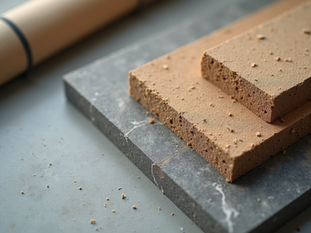
Unveiling the Future: The Surprising Impact of Eco-Friendly Materials on Modern Construction
15 minutes ago
4 min read
0
0
0
In recent years, the construction industry has undergone a remarkable change toward sustainability. The rise of eco-friendly materials is now a core aspect of modern construction practices. This shift is propelled by regulatory pressures and an increase in consumer awareness regarding the environmental effects of traditional building materials.
Eco-friendly materials include a diverse range of products, such as recycled steel, bamboo, reclaimed wood, and low-VOC (volatile organic compounds) paints. This post explores the importance of these materials and their role in shaping the future of construction.
The Demand for Sustainability
The growing demand for eco-friendly materials in construction is driven by various factors. Global climate change has intensified the need for industries to reassess their environmental impact. A recent survey showed that 75% of consumers are now willing to pay more for sustainable products, indicating a strong preference for greener choices in construction whether for homes or commercial spaces.
Governments worldwide are also instituting stricter regulations and incentives for the adoption of eco-friendly materials. According to a report by the World Green Building Council, buildings designed with sustainable practices not only lower environmental impact but can also lead to energy savings of up to 30%.
This transition is not just ethically sound but also economically smart. Investing in sustainable materials can significantly reduce operating costs over time, particularly through decreased energy consumption. For example, energy-efficient buildings can save up to 50% on heating and cooling expenses.
Innovations in Eco-Friendly Materials
The market for eco-friendly materials has expanded rapidly as manufacturers respond to rising demand. Some standout materials include:
Bamboo: This fast-growing plant has gained popularity as a durable alternative to hardwood. Bamboo can be used in various applications, including flooring, cabinetry, and even as structural materials. Buildings using bamboo can be completed in as little as half the time of traditional wooden structures.
Recycled Steel: Steel is among the most recycled materials on the planet. Using recycled steel in construction not only reduces landfill waste but also saves 60% of the energy needed to produce new steel, making it an eco-friendly choice.
Rammed Earth: A building technique that uses natural raw materials, rammed earth offers durability and excellent thermal mass. This method can lower heating and cooling costs by 30% compared to traditional buildings.
Insulated Concrete Forms (ICFs): Made from recycled materials, ICFs provide outstanding insulation, which can reduce energy use for heating and cooling by up to 50%.
These materials reduce the carbon footprint of construction while also enhancing the visual appeal of buildings, promoting a stylish and sustainable environment.
Sustainable Building Practices
Utilizing eco-friendly materials represents just one component of creating green buildings. Integrating sustainable building practices significantly enhances overall sustainability. Techniques such as passive solar design, rainwater harvesting, and green roofs have become standard in modern architecture.
Passive solar design optimizes a building's layout to maximize natural light and minimize reliance on heating and cooling systems. This strategy can cut energy costs by up to 20%, making it a key element of eco-friendly construction.
Rainwater harvesting systems can capture and reuse rainwater, reducing dependency on municipal water sources. In fact, a typical rainwater harvesting system can conserve over 30% of a household's water supply. Implementing green roofs also provides insulation, improves urban biodiversity, and helps with stormwater management.
The Role of Technology
Technology plays a vital role in promoting eco-friendly materials in modern construction. Advanced building technologies empower architects and builders to devise innovative and sustainable solutions.
Building Information Modeling (BIM) enhances design efficiency and resource management. By employing BIM, construction teams can evaluate the environmental impacts of materials before construction begins. This proactive approach improves material selection and decreases waste by up to 15%.
Emerging technologies like 3D printing are further revolutionizing construction. This technique, especially when combined with sustainable materials, can reduce construction time by 50% and minimize material waste significantly.

The Economic Benefits of Eco-Friendly Construction
Opting for eco-friendly materials can offer considerable economic benefits for builders and homeowners alike. While the initial investment may be higher, the long-term savings are substantial.
For instance, energy-efficient buildings typically cut utility costs by 30%. Additionally, the resilience of sustainable materials means fewer repairs and replacements are needed, boosting cost-effectiveness over time.
As the market for eco-friendly materials continues to grow, competition is likely to drive prices downward, improving accessibility. Consequently, eco-friendly materials present a compelling case for both environmental and economic benefits.
Challenges and Solutions
Despite the many advantages of eco-friendly materials, challenges remain. Issues like limited availability and higher upfront costs can deter builders and homeowners from transitioning to sustainable options.
To address these challenges, collaboration among governments, manufacturers, and the construction industry is essential. Increased investment in green technology and educational initiatives that highlight the advantages of sustainable materials can lead to broader adoption.
Developing local supply chains for eco-friendly materials can help reduce costs and improve access. Furthermore, public awareness campaigns can help educate homeowners about the long-term benefits of prioritizing eco-friendly materials in their projects.
A Greener Tomorrow with Eco-Friendly Choices
The rise of eco-friendly materials in construction marks a significant evolution in the building industry. These materials pave the way for sustainable living, showing that environmental responsibility can go hand-in-hand with style and functionality.
As technology advances and awareness increases, eco-friendly materials could become the standard for construction. The potential for a greener, healthier planet rests on the choices we make today. By embracing eco-friendly materials now, we can build a better future for generations to come.






